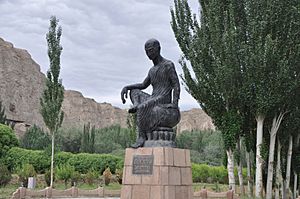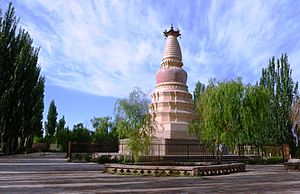Kumārajīva facts for kids
Quick facts for kids
Kumārajīva
|
|
|---|---|

|
|
| Born | 344 CE |
| Died | 413 CE (aged 68-69) |
| Occupation | Buddhist monk, scholar, translator, and philosopher |
| Known for | Translation of Buddhist texts written in Sanskrit to Chinese, founder of the Sanlun school of Mahayana Buddhism |
Kumārajīva (born 344 CE, died 413 CE) was a famous Buddhist monk, scholar, and translator. He came from the Kingdom of Kucha in what is now China. Many people see Kumārajīva as one of the most important translators in the history of Chinese Buddhism.
He was known for his amazing skill in translating ancient Buddhist texts. These texts were originally written in Sanskrit, an old Indian language. Kumārajīva translated them into Chinese. His translations were very clear and accurate.
Kumārajīva first studied the teachings of the Sarvastivada schools. Later, he became a follower of Mahayana Buddhism. He focused on the Mādhyamaka philosophy of Nāgārjuna. After learning Chinese, he became a leading translator in Chang'an around 401 CE. He led a team of scholars who helped him translate many important Buddhist books.
He also helped bring the Madhyamaka school of Buddhist philosophy to China. This school later became known as Sanlun, or the "Three Treatise school."
Contents
Life Story
Early Years
Kumārajīva's father, Kumārāyana, was from ancient India, possibly from Kashmir. His father was a prince who became a monk. He traveled to Kucha and became a royal priest there. Kumārajīva's mother, Jīva, was a princess from Kucha. She was a very religious Buddhist and greatly influenced his early studies.
When Kumārajīva was just seven years old, his mother became a nun. He started studying Buddhism at the age of nine. He learned from masters in North India, Kashmir, and Kucha. These places were important centers for Buddhist learning.
Later, he became a follower of Mahayana Buddhism. He studied under a teacher named Buddhayaśas in Kashgar. At 20, he became a fully ordained monk in Kucha. He studied different Buddhist philosophies and became famous for his wide knowledge and debate skills.
Captured and Released

In 379 CE, people in China heard about Kumārajīva's great abilities. The emperor of the Former Qin Dynasty, Fu Jian, wanted him to come to the capital city, Chang'an. So, he sent his general, Lü Guang, with an army to conquer Kucha and bring Kumārajīva back.
However, after a battle, Lü Guang decided to start his own state. He captured Kumārajīva, who was about 40 years old at the time. Lü Guang was not a Buddhist and kept Kumārajīva imprisoned for many years. During this time, Kumārajīva learned the Chinese language. He was also made to marry, which meant he could no longer be a monk in the traditional way.
Later, a new emperor, Yao Xing, came to power. He really wanted Kumārajīva to come to Chang'an. He asked Lü Guang many times to free him. When Lü Guang refused, Emperor Yao Xing sent armies to defeat him. Finally, in 401 CE, Kumārajīva was brought to Chang'an.
Life in Chang'an and Translation Work

In Chang'an, Kumārajīva met Emperor Yao Xing and other important leaders. He became very famous and respected in China. He was given the special title of "National Preceptor."
Kumārajīva led a large team of scholars. They worked together to translate many Sanskrit Buddhist texts into Chinese. Emperor Yao Xing treated him like his own teacher. Many Buddhist monks came to learn from him. They attended daily translation sessions where over a thousand monks gathered.
In about twelve years, Kumārajīva's team translated around 35 important Buddhist books. These translations are still used in Chinese Buddhism today. Kumārajīva had four main students who helped him: Daosheng, Sengzhao, Daorong, and Sengrui.
Important Work
How He Translated

Kumārajīva changed how Buddhist texts were translated in China. His team's translations were known for being very clear. Before him, translators often tried to match Buddhist words with old Chinese Daoist and Confucian terms. This sometimes caused confusion.
Kumārajīva's style was smooth and easy to read. He focused on making sure the meaning was clear, rather than translating word-for-word. Because of this, his translations of important Mahayana texts are still very popular. They are often preferred over later, more literal translations.
His translations also helped create many common terms used in Chinese Buddhism today. For example:
- 大乘 (Dà chéng) for Mahāyāna, meaning "greater vehicle."
- 菩提 (pú tí) for Bodhi, meaning "awakening."
The translation process was a team effort. Kumārajīva would read the text and explain it in Chinese. Then, the Chinese monks and students would discuss it. They would work together to create a Chinese translation. Kumārajīva would check it, and it would be written down and revised many times. Even the emperor attended these public translation sessions!
Kumārajīva also created a way to write Sanskrit words using Chinese sounds. This system later helped in the development of pinyin, which is used to write Chinese sounds in English letters. His work even influenced the Chinese language itself, adding new words and ideas.
Texts He Translated
Kumārajīva and his team translated many important Buddhist texts. There are 52 translations under his name that are still used today. These include important Mahayana sutras and works on Buddhist meditation.
Sutras
Some of the most important sutras translated by Kumārajīva and his team include:
- Vajracchedikā Prajñāpāramitā Sūtra (the Diamond Sutra)
- Saddharma Puṇḍarīka Sūtra (the Lotus Sutra)
- Vimalakirti Nirdesa Sutra
- Aṣṭasāhasrikā Prajñāpāramitā Sūtra
Treatises
They also translated several key philosophical texts, mainly from the Madhyamaka school. These became very important for East Asian Madhyamaka Buddhism. Some of these are:
- The Middle Treatise (Ch. 中論), which includes Nāgārjuna's Mūlamadhyamakakārikā (Fundamental Verses on the Middle Way).
- The Treatise on the Twelve Gates (Ch. 十二門論).
- The Hundred(-Verse) Treatise (Ch. 百論).
- "Commentary on the Great Perfection of Wisdom" (Ch. 大智度論). This text is sometimes thought to have additions by Kumārajīva's team.
Meditation Texts
Kumārajīva and his team also translated some important texts about meditation. These texts taught different ways to calm the mind and develop wisdom. They included practices like cultivating kindness, thinking about how things come to be, and focusing on breathing.
These meditation practices were seen as ways to help people reach higher levels of understanding. They also helped bodhisattvas (people aiming for Buddhahood) perfect themselves to help others.
His Own Ideas

Kumārajīva also wrote some of his own works. These include his Commentary on the Vimalakīrti-nirdesa-sūtra. He and his team also wrote a biography of Nagarjuna.
His philosophical ideas were very similar to those of Nagarjuna. He emphasized the idea of emptiness, which means that all things are empty of a fixed, separate self. He also taught that a Bodhisattva should not be attached to anything.
His Impact
Kumārajīva's translation work had a huge impact on Chinese Buddhism. Before him, many Chinese Buddhists misunderstood the ideas of emptiness and not-self. They sometimes confused these ideas with other Chinese philosophies.
Kumārajīva and his students helped correct these misunderstandings. They introduced proper explanations based on Indian Madhyamaka philosophy. This helped Chinese Buddhists understand these deep ideas much better.
See also
 In Spanish: Kumarajiva para niños
In Spanish: Kumarajiva para niños
- Chinese Translation Theory
- Silk Road transmission of Buddhism

